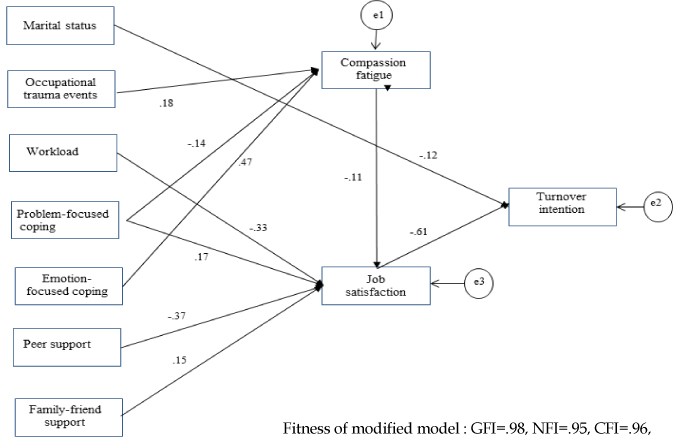J Korean Acad Nurs Adm.
2016 Dec;22(5):562-569. 10.11111/jkana.2016.22.5.562.
Factors Influencing Turnover Intention in Clinical Nurses: Compassion Fatigue, Coping, Social Support, and Job Satisfaction
- Affiliations
-
- 1College of Nursing, Dankook University, Cheonan, Korea. jongkimk@dankook.ac.kr
- KMID: 2367010
- DOI: http://doi.org/10.11111/jkana.2016.22.5.562
Abstract
- PURPOSE
This study was done to construct and verify a model of turnover intention in clinical nurses, considering the effects of compassion fatigue, coping, social support, and job satisfaction.
METHODS
For this study a cross-sectional correlational design was used. Participants were 283 clinical nurses in four general hospitals. Data were collected using a questionnaire and were analyzed with descriptive statistics, Pearson correlation coefficient and path analysis.
RESULTS
The modified model of turnover intention had a good fit in this study. Turnover intention was influenced by job satisfaction, and job satisfaction was affected by workload, problem-focused coping, peer support, family-friend support and compassion fatigue. Compassion fatigue was associated with occupational trauma events, problem-focused coping and emotional-focused coping. Job satisfaction was the most important factors controlling nurse's turnover intention.
CONCLUSION
Findings show that job satisfaction, compassion fatigue, and traumatic events are important factors influencing turnover intention. Nurse managers try to manage job satisfaction, compassion fatigue, support, and coping for nurses, it could be expected making proper nursing circumstance.
Keyword
MeSH Terms
Figure
Reference
-
1. Kim JK, Kim MJ. A review of research on hospital nurses' turnover intention. J Korean Acad Nurs Adm. 2011; 17(4):538–550. DOI: 10.11111/jkana.2011.17.4.538.2. Bettencourt LA, Brown SW. Role stressors and customer-oriented boundary spanning behaviors in service organizations. J Acad Market Sci. 2003; 31(4):394–408. DOI: 10.1177/0092070303255636.3. Sung K, Seo Y, Kim JH. Relationships between compassion fatigue, burnout, and turnover intention in Korean hospital nurses. J Korean Acad Nurs. 2012; 42(7):1087–1094. DOI: 10.4040/jkan.2012.42.7.1087.4. Joinson C. Coping with compassion fatigue. Nursing. 1992; 22:116118–119. 1205. Lazarus RS, Folkman S. Stress, appraisal and coping. New York: Springer Publishing Company;1984.6. Coetzee SK, Klopper HC. Compassion fatigue within nursing practice: A concept analysis. Nurs Health Sci. 2010; 12(2):235–243. DOI: 10.1111/j.1442-2018.2010.00526.x.7. Bride BE, Radey M, Figley CR. Measuring compassion fatigue. Clin Soc Work J. 2007; 35(3):155–163. DOI: 10.1007/s10615-007-0091-7.8. Figley CR. Compassion fatigue as a secondary traumatic stress disorder: An overview. In : Figley CR, editor. Compassion fatigue: Coping with secondary traumatic stress disorder in those who treat the traumatized. New York: Brunner/Mazel;1995. p. 1–17.9. Buurman BM, Mank AP, Beijer HJ, Olff M. Coping with serious events at work: A study of traumatic stress among nurses. J Am Psychiatr Nurses Assoc. 2011; 17(5):321–329. DOI: 10.1177/1078390311418651.10. Southwick SM, Vythilingam M, Charney DS. The psychobiology of depression and resilience to stress: Implications for prevention and treatment. Annu Rev Clin Psychol. 2005; 1:255–291. DOI: 10.1146/annurev.clinpsy.1.102803.143948.11. Pronost AM, Le Gouge A, Leboul D, Gardembas-Pain M, Berthou C, Giraudeau B, et al. Relationships between the characteristics of oncohematology services providing palliative care and the sociodemographic characteristics of caregivers using health indicators: Social support, perceived stress, coping strategies, and quality of work life. Support Care Cancer. 2012; 20(3):607–614. DOI: 10.1007/s00520-011-1139-3.12. Kim HJ. The relationships between traumatic events, compassion fatigue, burnout and compassion satisfaction in emergency nurses [master's thesis]. Chungju: Konkuk University;2011.13. Yang YH, Kim JK. A literature review of compassion fatigue in nursing. Korean J Adult Nurs. 2012; 24(1):38–51.14. Price JL, Mueller CW. A causal model of turnover for nurses. Acad Manage J. 1981; 24(1):543–565. DOI: 10.2307/255574.15. Mobley WH. Intermediate linkages in the relationship between job satisfaction and employee turnover. J Appl Psychol. 1977; 62(2):237–240. DOI: 10.1037/0021-9010.62.2.237.16. Bae BR. Structural equation model with LISREL: Concepts, application, and programing. 2nd ed. Seoul: Chungram Publishing;2005.17. Niiyama E, Okamura H, Kohama A, Taniguchi T. A survey of nurses who experienced trauma in the workplace: Influence of coping strategies on traumatic stress. Stress Health. 2009; 25(1):3–9. DOI: 10.1002/smi.1217.18. Yang YH. The comparison of the coping patterns of cancer patients and their caregivers according to the phases of illness. J Korean Acad Nurs. 1998; 28(4):970–979.19. Park JW. A study for development of social support [dissertation]. Seoul: Yonsei University;1985.20. Stamm BH. Professional quality of life: Compassion satisfaction and fatigue (ProQOL) Version 5 [Internet]. 2009. cited 2016 July 1. Available from URL: http://www.texasbar.com/AM/Template.cfm?Section=Wellness1&Template=/CM/ContentDisplay.cfm&ContentID=15157.21. Park SA, Yun SN. Measurement of job satisfaction of nurses and health workers in health centers. J Nurs Acad Soc. 1992; 22(3):316–324.22. Stamp PL, Piedmont EB, Slavitt DB, Hasse AM. Measurement of work satisfaction among health professionals. Med Care. 1978; 16(4):337–352.23. Park HS. Relationship between perceived nursing care role orientation, job characteristics, and turnover among nurses [master's thesis]. Seoul: Yonsei University;2002.24. Lawler EE. Satisfaction and behavior. In : Hackman JR, Lawler EE, Porter LW, editors. Perspectives on behavior in organizations. 2nd ed. New York: McGraw-Hill;1983. p. 78–97.25. Beck CT. Secondary traumatic stress in nurses: A systematic review. Arch Psychiatr Nurs. 2011; 25(1):1–10. DOI: 10.1016/j.apnu.2010.05.005.26. Jeon SY, Ha JY. Traumatic events, professional quality of life and physical symptoms among emergency nurses. Korean J Adult Nurs. 2012; 24:64–73. DOI: 10.7475/kjan.2012.24.1.64.27. Yang YS, Kang YH. ICU New nurses' job stress, job satisfaction, organizational commitment and turnover intention. Nurs Sci. 2013; 25(2):47–52.
- Full Text Links
- Actions
-
Cited
- CITED
-
- Close
- Share
- Similar articles
-
- Effects of Compassion Satisfaction and Social Support in the Relationship between Compassion Fatigue and Burnout in Hospital Nurses
- Factor Influencing New Graduate Nurses' Turnover Intention according to Length of Service
- Relationship between Job Stress and Compassion Satisfaction, Compassion Fatigue, Burnout for Nurses in Children's Hospital
- Effect of Job Embeddedness and Job Satisfaction on Turnover Intention in Nurses
- Effect of Shiftwork Nurses' Fatigue on Job Stress and Turnover Intention: Mediating Role of Job Stress


